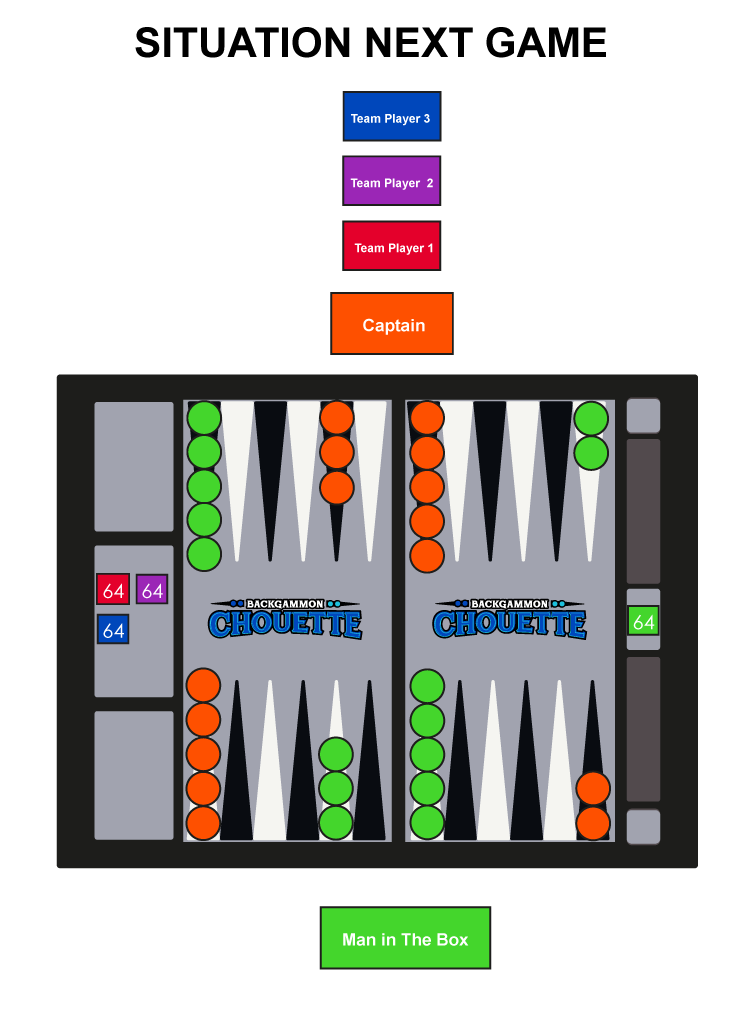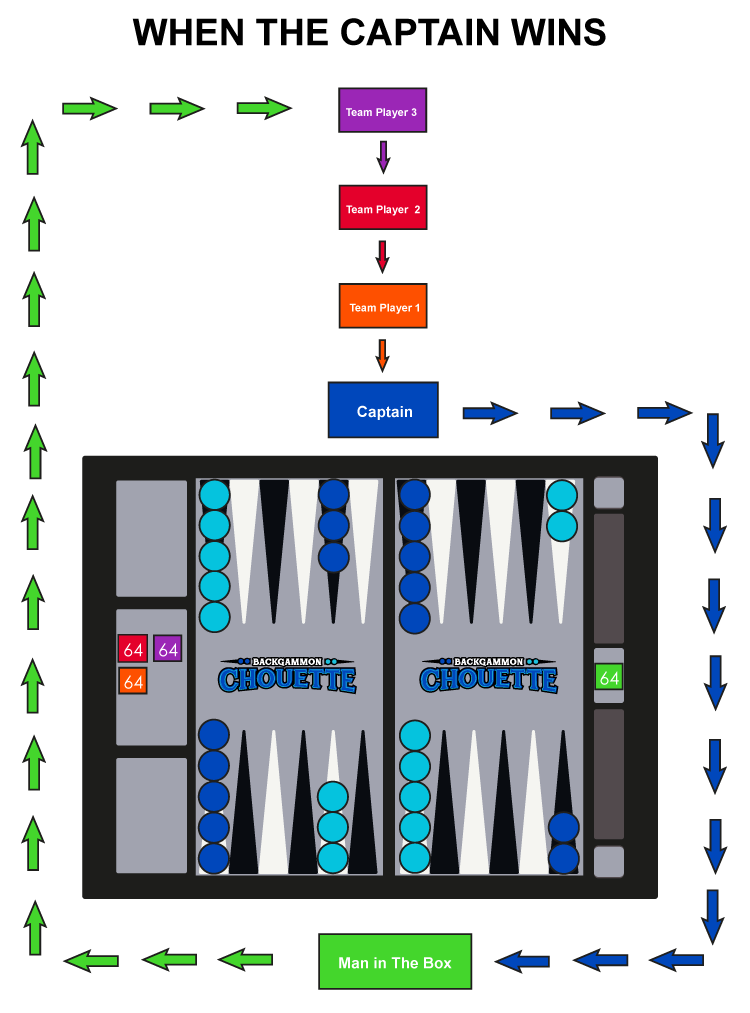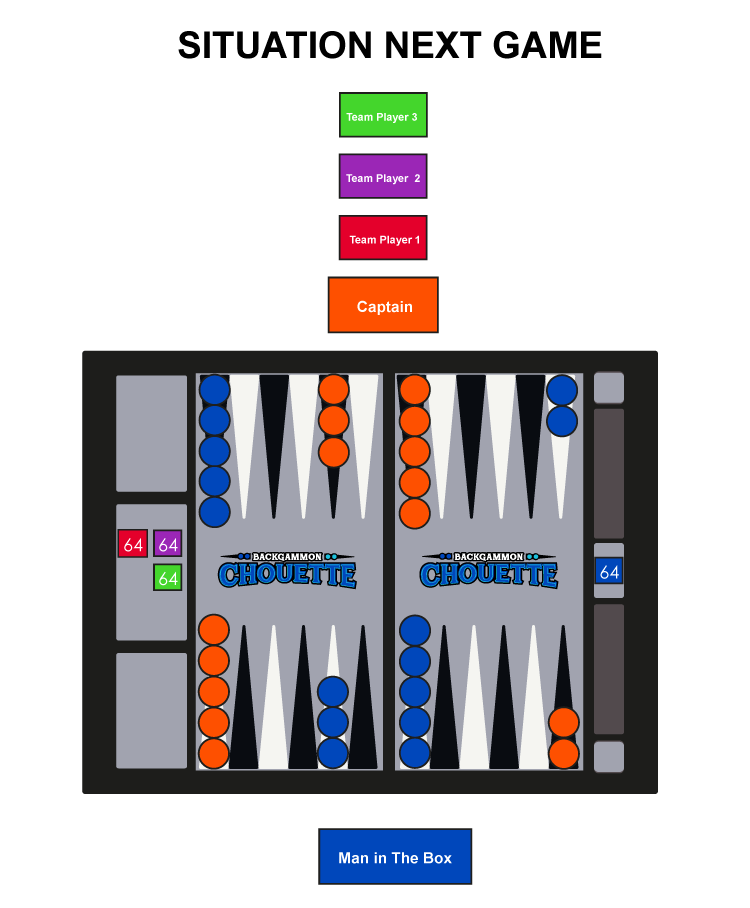Welcome to our guide on Backgammon Chouette! You may wonder how player rotation works if you’re new to the game. Luckily, we’re here to explain it to you and show you how our professional Chouette set makes it even clearer.
In the following example, we’ll be using all the components of the Chouette set, including each player’s colorful checkers and cube. Get ready to learn how player rotation works!
The Start of the Game Determines Who Becomes the Man in the Box
First, we throw the dice to determine the order and colors. The results are in:
- Green is the man in the Box
- Blue is the Captain
- Orange is the first team member in the front row
- Red is the second team member in line
- Purple is the team member at the back of the queue.
Now that we know the order, we can dive into how player rotation works in Backgammon Chouette. Read on to find out more!

In the example, you’ll see that Green is the man in the Box. You can tell because Green is facing the correct direction of the logo, and their green Doubling Cube is placed on the right side of the board.
The player in the role of Captain is Blue. Since Blue is playing directly against the Man in the Box, their Doubling Cube is not in play.
At the start of the game, each team member places their Doubling Cube on the left side of the board in the middle. This helps to keep track of which team members are participating and who has control of the doubling cube during the game.
Box Wins
The change in the order in case the BOX wins
- If the Box wins, it keeps its position as the Box. However, since multiple players are involved, the Box might win against some players but lose against others. To decide who remains the Box in case of different outcomes, always remember the golden rule: the Box must beat the Captain to retain its position.

- If the Box wins, the Box remains the Box, and the Captain joins the back of the line. In our example, the player first in line, Orange, is now up to take on the Box on behalf of the team.
The situation regarding the order of the next game then looks like this:

The player who played as the Box (Green) and won the previous game will continue to play as the Box in the next game. The player who played as the previous Captain (Blue) and lost the game will move to the back of the line. The player who was previously at the front of the line (Orange) will become the new Captain and move forward. You can easily identify the new Captain because the Cube on the right side of the line will still be green (the color of the Box). The Cube representing the new Captain will also be green because they will play against the Box. The three remaining team members will be on the left side of the line. The blue Cube will be added to the team, and the Orange Cube will be removed from the game.
Captain Wins
Let’s revisit the scenario where Green is the “Box” player and Blue is the “Captain” player. We’ve already discussed what would happen if Green won. Now, let’s consider the opposite scenario where the Captain (Blue) wins against the Box (Green):

The roles are switched when the “Captain” player defeats the “Box” player. So, in our example, when Blue wins against Green, Blue becomes the new “Box” player, and Green joins the team at the back of the queue. The next player in line, Orange, will now play against Blue as the new “Box” player on behalf of the team.
Therefore, the order of the next game will be Orange (team member) vs. Blue (new “Box” player).

Additional Rules
- When playing Chouette with multiple players and double dice, the “Box” player may win against some team members but lose against others. To determine whether the “Box” player maintains their position, an important rule applies: the “Box” player remains the “Box” player as long as they defeat the Captain player.
- Each partner can decline individually if the “Box” player offers a double. If a team member declines the double, they lose their bet but their position in the team’s ranking is unaffected.
- If the Captain player refuses to accept a double offered by the “Box” player, they lose the game, their bet, and their position. The Captain player will rotate to the back of the team in the next game.
- If the Captain player declines the double, other team members can accept it. The highest-ranking team member who accepts becomes the acting Captain for the remainder of that particular game.
- Accepting or declining a double does not change a team member’s rank, except when the Captain player declines. In that case, the Captain player always loses their position, even if the accepting partners ultimately win the game.
- For example, if the “Box” player doubles, the Captain declines, and the first team member in line also declines, but the next player accepts, they become the acting Captain. However, if this player wins, they will not become the “Box” player in the next game but will only advance in the order. The player in line after the Captain player becomes the new “Box” player, even if they lost the previous game.
- A player can indicate they want to stop at the end of a single game, regardless of whether they are winning or losing. If enough seats are available, a new player can join before each new game and will start as a team member at the back of the queue.
- It is not allowed for a player to pass the “Box” position by stopping just before becoming the “Box” player and then re-entering the next game as the last-ranked team player. Not playing or skipping the “Box” position is not allowed.
- If the Captain player doubles but the rest of the players do not, and the “Box” player drops, the next player in line becomes the acting Captain and ends the game. The Captain player who beats the “Box” player with their double automatically becomes the “Box” player in the next game.
